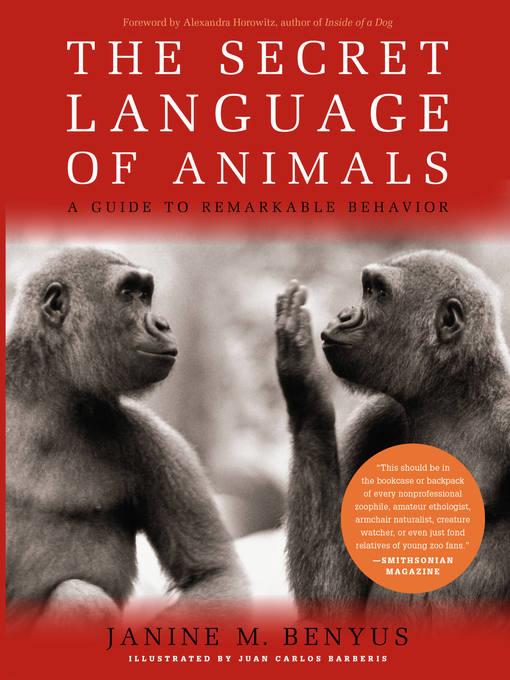
The Secret Language of Animals
A Guide to Remarkable Behavior
کتاب های مرتبط
- اطلاعات
- نقد و بررسی
- دیدگاه کاربران
نقد و بررسی

April 1, 2014
Nature writer Benyus (Biomimicry: Innovation Inspired by Nature, 1997, etc.) defends the value of zoos even though scarcely 10 percent meet the standard for accreditation by the American Association of Zoological Parks and Aquariums. "Though captive breeding is a number one priority at many zoos," writes the author, "it is not always obvious to the casual visitor." Zoos also play an important role in educating children about the need to protect and nurture wildlife. Benyus' aim in this update (the book was originally published in 1998) is to guide young and old visitors in better understanding the behaviors of the animals on view. To this end, she provides snapshots of their behaviors in the wild, organized geographically and by species, and how this translates to the protected environment of a nature park--the proper conception of a well-run zoo. "If you haven't been to a zoo in several years, you're in for a wild surprise....[t]hey've sprung the cages and turned the animals loose in startling simulations of their home habitats," she writes. In a properly administered zoo, solitary animals no longer exhibit stereotypical behavior. "Besides being more at home, the animals are also in better company," writes Benyus. "No longer the lone representative of their species, they now romp in herds and pods, troops and bevies." From African gorillas and lions to peacocks, North American wolves and eagles, Arctic polar bears and whales, the author covers the typical behaviors of different species, their feeding, locomotion, grooming, vocalizations, gestures and courtship rituals, social organization and raising of young. Most of us will never go on a safari, but with Benyus' guidance, supplemented with more than 200 charming illustrations, a visit to the zoo can be educational and provide thrills galore--and we can play an important role by observing that the animals are being properly treated.
COPYRIGHT(2014) Kirkus Reviews, ALL RIGHTS RESERVED.

September 15, 2014
This clear and concise guide offers sections on creatures of the African jungles, plains, and waterways; Asian forests; warm oceans; North America; and the Poles. Within those sections the material is laid out animal by animal, with information on the communication habits of, for example, the gorilla, lion, African elephant, plains zebra, black rhinoceros, giraffe, ostrich, Nile crocodile, giant panda, peacock, bottlenose dolphin, gray wolf, bald eagle, polar bear, and Adelie penguin. The book opens with a discussion of zoos, for Benyus (A Field Guide to Wildlife; Northwoods Wildlife) is a proponent of well-managed and carefully thought-out facilities as a means of animal preservation while the fragile earth is slowly yet carefully brought back from the brink of ruin. These early pages also provide primer material on general animal behavior, complete with a discussion of habitat, basic behaviors, interacting strategies, and more. A number of pen-and-ink drawings also complement this first chapter. VERDICT Benyus's approachable writing can easily be understood and navigated, and her topic will be compelling to a wide range of library patrons.--Susan E. Brazer, Salisbury Univ. Lib., MA
Copyright 2014 Library Journal, LLC Used with permission.

March 15, 2014
Humans have always pondered what makes us different from animals. After all, many species exhibit behaviors that resemble our own (or is it the other way around?). This informative volume covers 20 of the world's most well-known animals, including African elephants, flamingos, giant pandas, Nile crocodiles, and polar bears. Divided by geographical regions ( African Jungles, Plains, and Waterways; Asian Forests; Warm Oceans; North America; and The Poles ), the chapters cover some of the basic habits and behaviors of a particular animal, such as elimination, self-grooming, and sleeping. Social behaviors, from friendly to threatening, are discussed, as are sexual and parental interactions. Numerous sidebars showcase vital stats on each animal, quirky facts, and trivia. Each chapter ends with a list of behaviors for readers to look for at the zoo or in the wild.Plentiful introductory material highlights zoo conditions and habitat simulation and includes a lengthy overview of how animals behave in general. Noted nature illustrator Juan Carlos Barberis supplies artful line drawings. The narrative is extremely accessible, and readers of all ages will enjoy learning something new about their favorite zoo animals. Recommended for most public libraries, where this would do well in the circulating collection.(Reprinted with permission of Booklist, copyright 2014, American Library Association.)

























دیدگاه کاربران